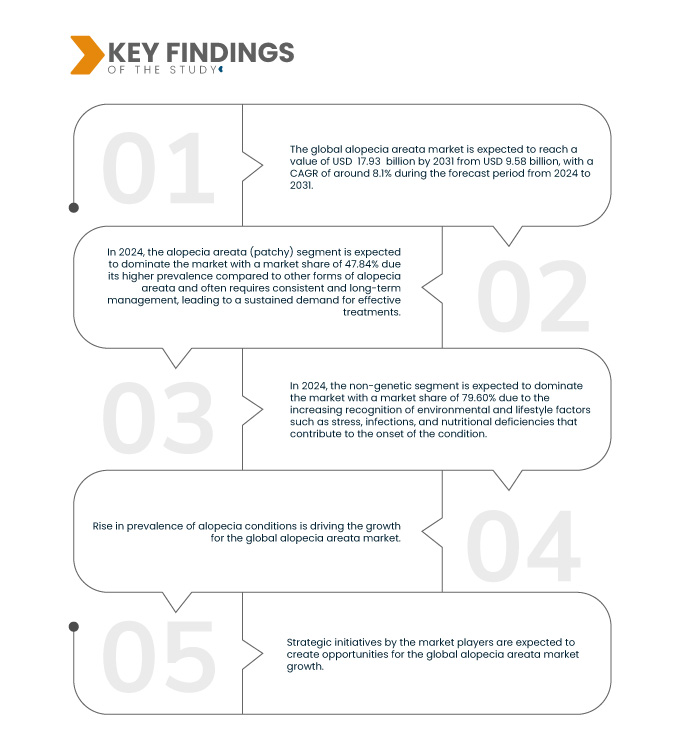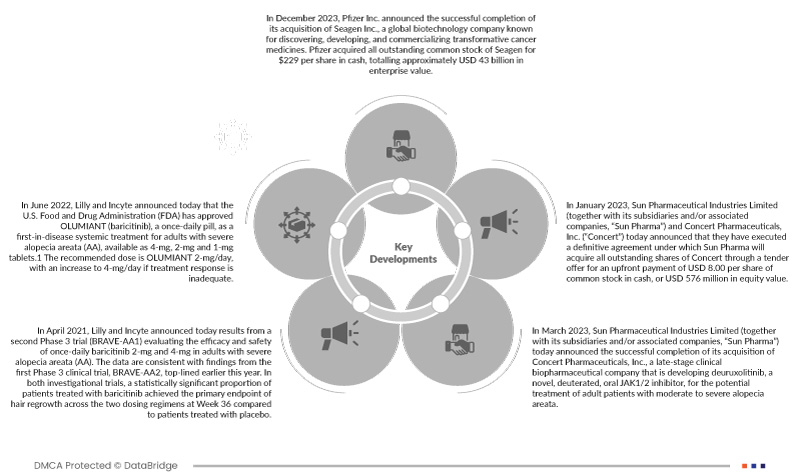The escalating demand of alopecia treatment options has been observed across all over the globe and the reason behind is the rapid surge in hair loss among the old aged population. The older people are suffering from alopecia (hair loss) and used to rely on one or more than one type of alopecia treatment so as to achieve effective results. The older adult population is expanding, living longer but with several dermatological problems such as alopecia (hair loss) among others. Aging results in aging of hair follicles which affects the hair growth. In older women, androgenetic alopecia is a common problem after the menopause. This has been reported by the scientists that older women have shrunken hair follicles that restrict the process of hair growth. The hair loss is a major concern among the older population and hence they look for an effective treatment options. The geriatric population is expanding dramatically. As the aging progress individuals suffers from the problem of hair loss.
Access Full Report @ https://www.databridgemarketresearch.com/es/press-release/global-alopecia-areata-market
Data Bridge Market Research analyzes that the Global Alopecia Areata Market is growing with a CAGR of 8.1% in the forecast period of 2024 to 2031 and is expected to reach USD 17.93 billion by 2031 from USD 9.58 billion in 2023.
Key Findings of the Study
Rise in Prevalence of Alopecia Conditions
Alopecia has become a major concern now days due to changing lifestyles and worse environmental conditions. Androgenetic alopecia is an extremely common disorder which has been reported to affect approximately 50% of men and maximum numbers of women have also been reported to affect with alopecia. Along with androgenetic alopecia, the surge in number of alopecia areata cases have also reported, alopecia areata is an autoimmune disorder and affects as many as 6.8 million people in the U.S. This has also been reported that people of all ages, every type of sexes and every ethnic groups suffers from alopecia areata, moreover, it also affects children. The number of individuals suffering from alopecia is increasing worldwide which has led to enhanced demand of safe and effective treatment. As the prevalence of alopecia is increasing worldwide the sufferers are adopting the most advanced, innovative, safe and effective treatment options in order to achieve the best treatment. Thus increasing prevalence of alopecia conditions is acting as the driver for the alopecia market growth.
Report Scope and Market Segmentation
|
Report Metric
|
Details
|
|
Forecast Period
|
2024 to 2031
|
|
Base Year
|
2023
|
|
Historic Year
|
2022 (Customizable 2016-2021)
|
|
Quantitative Units
|
Revenue in USD Billion
|
|
Segments Covered
|
Disease Type (Alopecia Areata (Patchy), Alopecia Areata Totalis, Alopecia Areata Universalis and Others), Cause (Non-Genetic and Genetic), By Type (Treatment and Diagnosis), Age Group (Below 18 Years, 18-50 Years and Above 50 Years), Gender (Female and Male)
|
|
Countries Covered
|
U.S., Canada, Mexico, Germany, France, U.K., Italy, Spain, Netherlands, Russia, Switzerland, Turkey, Austria, Norway, Hungary, Lithuania, Ireland, Poland, Rest of Europe, Japan, China, South Korea, Australia, India, Singapore, Malaysia, Thailand, Indonesia, Philippines, Vietnam, Rest of Asia-Pacific, Brazil, Argentina, Peru, Rest of South America, Saudi Arabia, South Africa, U.A.E., Kuwait, Israel, Egypt, and Rest of Middle East and Africa
|
|
Market Players Covered
|
Pfizer Inc. (U.S.), Dr. Reddy's Laboratories (India), Lilly (U.S.), Sun Pharmaceutical Industries Ltd. (India), GSK plc. (UK), Johnson & Johnson Consumer Inc. (U.S.), Croma-Pharma GmbH (Austria), Viviscal (U.S.), AdvaCare Pharma (U.S.), Wellona Pharma (India), Teva Pharmaceuticals USA, Inc. (Israel), Follicum AB (Sweden), Nanogen (U.K.), Vitabiotics Ltd. (England), Reistone Biopharma (China), and TechnoDerma Medicines Inc. (China), among others.
|
|
Data Points Covered in the Report
|
In addition to the insights on market scenarios such as market value, growth rate, segmentation, geographical coverage, and major players, the market reports curated by the Data Bridge Market Research also include depth expert analysis, patient epidemiology, pipeline analysis, pricing analysis, and regulatory framework.
|
Segment Analysis
Global alopecia areata market is segmented into five notable segments which are disease type, cause, type, age group, gender.
- On the basis of disease type, global alopecia areata market is segmented into alopecia areata (patchy), alopecia areata totalis, alopecia areata universalis and others
In 2024, alopecia areata (patchy) segment is expected to dominate the global alopecia areata market
In 2024, the alopecia areata (patchy) segment is expected to dominate the market with a market share of 47.84% due its higher prevalence compared to other forms of alopecia areata and often requires consistent and long-term management, leading to a sustained demand for effective treatments.
- On the basis of cause, global alopecia areata market is segmented into non-genetic and genetic
In 2024, non-genetic segment is expected to dominate the global alopecia areata market
In 2024, the non-genetic segment is expected to dominate the market with a market share of 79.60% due to the increasing recognition of environmental and lifestyle factors such as stress, infections, and nutritional deficiencies that contribute to the onset of the condition.
- On the basis of type, global alopecia areata market is segmented into treatment and diagnosis. In 2024, treatment segment is expected to dominate the market with a market share of 73.18%
- On the basis of age group, global alopecia areata market is segmented into below 18 years, 18-50 years and above 50 years. In 2024, below 18 years segment is expected to dominate the market with a market share of 51.70%
- On the basis of gender, global alopecia areata market is segmented into female and male. In 2024, female segment is expected to dominate the market with a market share of 63.30%
Major Players
Data Bridge Market Research analyzes Pfizer Inc. (U.S.), Dr. Reddy's Laboratories (India), Lilly (U.S.), Sun Pharmaceutical Industries Ltd. (India), GSK plc. (UK) as the major market players of the market.
Market Developments
- In January 2024, Lilly announced today that OLUMIANT (baricitinib) received regulatory approval for its severe alopecia areata indication via Notice of Compliance (NOC) from Health Canada. OLUMIANT is taken once daily, as a systemic treatment for adults with severe alopecia areata (AA), as 2 mg or 4 mg tablets orally. The recommended dose of OLUMIANT for patients living with severe alopecia areata is 2 mg/day, with an increase to 4 mg/day if treatment response is not adequate. For patients with nearly complete or complete scalp hair loss, with or without substantial eyelash or eyebrow hair loss, a starting dose 4 mg/day may be considered. Once an adequate response is achieved on 4 mg/day, dose reduction to 2 mg/day may be considered. OLUMIANT is not recommended for use in combination with other JAK inhibitors, biologic immunomodulators, azathioprine, cyclosporine or other potent immunosuppressants
- In December 2023, Pfizer Inc. announced the successful completion of its acquisition of Seagen Inc., a global biotechnology company known for discovering, developing, and commercializing transformative cancer medicines. Pfizer acquired all outstanding common stock of Seagen for USD 229 per share in cash, totalling approximately USD 43 billion in enterprise value
- In July 2023, Reistone has reported positive topline Phase 2 results for SHR0302, highlighting its efficacy as a selective JAK1 inhibitor in treating patients with alopecia areata. These results suggest promising outcomes in managing the autoimmune-driven hair loss condition, potentially offering new hope for affected individuals
- In June 2023, Pfizer Inc. announced that the U.S. Food and Drug Administration (FDA) has approved LITFULO™ (ritlecitinib), a once-daily oral treatment for individuals aged 12 and older with severe alopecia areata. The approved recommended dose for LITFULO is 50 mg. This approval makes LITFULO the first and only FDA-approved treatment for adolescents (12+) with severe alopecia areata
- In March 2023, Sun Pharmaceutical Industries Limited (together with its subsidiaries and/or associated companies, “Sun Pharma”) announced the successful completion of its acquisition of Concert Pharmaceuticals, Inc., a late-stage clinical biopharmaceutical company that is developing deuruxolitinib, a novel, deuterated, oral JAK1/2 inhibitor, for the potential treatment of adult patients with moderate to severe alopecia areata
- In March 2023, Viviscal a leader in hair growth supplements and long-time partner for millions of men and women in their hair growth journeys — has introduced a new suite of innovative topical hair care products to address women's hair concerns. The new suite is comprised of a Viviscal Thickening Shampoo, Viviscal Strengthening Conditioner, Viviscal Exfoliating Scalp Scrub, and Viviscal Thickening Serum
- In June 2022, Lilly and Incyte announced today that the U.S. Food and Drug Administration (FDA) has approved OLUMIANT (baricitinib), a once-daily pill, as a first-in-disease systemic treatment for adults with severe alopecia areata (AA), available as 4-mg, 2-mg and 1-mg tablets.1 The recommended dose is OLUMIANT 2-mg/day, with an increase to 4-mg/day if treatment response is inadequate
Regional Analysis
Geographically, the countries covered in the global Alopecia Areata market report are the U.S., Canada, Mexico, Germany, France, U.K., Italy, Spain, Netherlands, Russia, Switzerland, Turkey, Austria, Norway, Hungary, Lithuania, Ireland, Poland, Rest of Europe, Japan, China, South Korea, Australia, India, Singapore, Malaysia, Thailand, Indonesia, Philippines, Vietnam, Rest of Asia-Pacific, Brazil, Argentina, Peru, Rest of South America, Saudi Arabia, South Africa, U.A.E., Kuwait, Israel, Egypt, and Rest of Middle East and Africa.
As per Data Bridge Market Research analysis:
North America is the dominant region in the global Alopecia Areata market during the forecast period of 2024 to 2031
North America is expected to dominate the market due to increasing prevalence rate of viral respiratory infections and its evolving treatment options. North America will continue to dominate the market in terms of market share and revenue and flourish its dominance during the forecast period.
Asia-Pacific is estimated to be the fastest-growing region in the global Alopecia Areata market during the forecast period of 2024 to 2031
Asia-Pacific is expected to grow during the forecast period due to its increasing prevalence of the condition, rising healthcare expenditures, and growing awareness of advanced treatment options.
For more detailed information about the global Alopecia Areata market report, click here – https://www.databridgemarketresearch.com/es/reports/global-alopecia-areata-market














